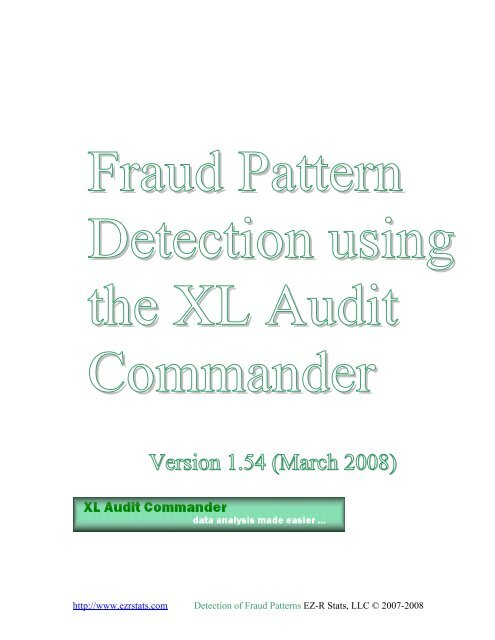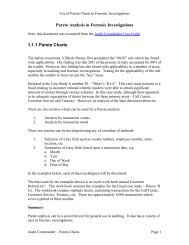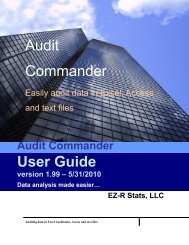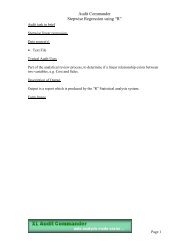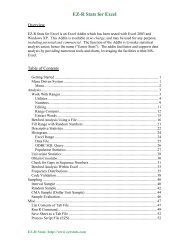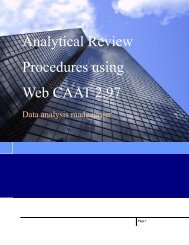Detection using the XL Audit Commander
XL Audit Commander - EZ-R Stats, LLC
XL Audit Commander - EZ-R Stats, LLC
- No tags were found...
Create successful ePaper yourself
Turn your PDF publications into a flip-book with our unique Google optimized e-Paper software.
Fraud Pattern<strong>Detection</strong> <strong>using</strong><strong>the</strong> <strong>XL</strong> <strong>Audit</strong><strong>Commander</strong>Version 1.54 (March 2008)http://www.ezrstats.com <strong>Detection</strong> of Fraud Patterns EZ-R Stats, LLC © 2007-2008
<strong>XL</strong> <strong>Audit</strong> <strong>Commander</strong><strong>Detection</strong> of Fraud Patterns<strong>Detection</strong> of certain types of fraud patterns can be achieved <strong>using</strong> <strong>the</strong> <strong>XL</strong> <strong>Audit</strong> Theprimary purpose of <strong>the</strong> tool is to support forensic accounting and fraud investigations,although it may find o<strong>the</strong>r uses in research and as a general purpose accounting supporttool. This is free software, <strong>the</strong>re is no license cost, and it may be used without restrictionfor any purpose, including commercial and educational.The tool is installed as an Excel add-in, and as such requires Excel 2000 or later. Thetool works only on Windows operating systems.The techniques described here for <strong>the</strong> detection of fraud patterns require that <strong>the</strong> data tobe analyzed be in “tab separated value” format and also be sorted. If <strong>the</strong> data to beanalyzed is not in tab separated value format, <strong>the</strong>re is an explanation of how to convertdata in <strong>the</strong> white paper located athttp://www.ezrstats.com/doc/Process_To_Convert_Data_To_TSV.pdf.This paper is divided into two sections –1) Procedure for <strong>the</strong> detection of fraud patternsand 2) Example output reports produced <strong>using</strong> <strong>the</strong> data provided with <strong>the</strong> softwareinstallation.http://www.ezrstats.com <strong>Detection</strong> of Fraud Patterns EZ-R Stats, LLC © 2007-2008
<strong>XL</strong> <strong>Audit</strong> <strong>Commander</strong><strong>Detection</strong> of Fraud PatternsFraud Pattern detection........................................................................................................................... 1Overview..................................................................................................................... 1Histograms .................................................................................................................. 2Kolmogorov-Smirnov Test ......................................................................................... 5How <strong>the</strong> test works...................................................................................................... 5The “d-statistic” .......................................................................................................... 5An example illustration <strong>using</strong> Excel........................................................................... 6Comparative income Statements................................................................................. 6Chi Square................................................................................................................... 7Form............................................................................................................................7Column Meanings....................................................................................................... 8System Limitations ................................................................................................... 10Sort Sequence............................................................................................................ 10Processing Output ..................................................................................................... 10Examples of processing (including output) .............................................................. 10Example Reports .................................................................................................................................. 17Benford’s Law .......................................................................................................... 17Univariate Statistics .................................................................................................. 18Round Numbers ........................................................................................................ 20Day of Week Analysis .............................................................................................. 22Holiday Analysis....................................................................................................... 23Stratification.............................................................................................................. 24Trend......................................................................................................................... 25Summary and Recap............................................................................................................................. 28http://www.ezrstats.com <strong>Detection</strong> of Fraud Patterns EZ-R Stats, LLC © 2007-2008
Fraud Pattern detection<strong>XL</strong> <strong>Audit</strong> <strong>Commander</strong><strong>Detection</strong> of Fraud PatternsOverviewThe purpose of <strong>the</strong> fraud pattern detection routines is to divide <strong>the</strong> population intocomponents and <strong>the</strong>n quantitatively assess to what extent each component differs from<strong>the</strong> population as a whole, <strong>using</strong> one of seven types of attributes or tests:1. Existence of round numbers2. Benford’s Law3. Days of <strong>the</strong> week4. Occurrence of U.S. Federal holidays5. Coefficient of variation6. Data Stratification7. Trend lines (“best fit”)By automating <strong>the</strong> process of identification of population components which differsignificantly from <strong>the</strong> remainder of <strong>the</strong> population, <strong>the</strong> process is speeded up and <strong>the</strong>likelihood of identifying error/fraud transactions is increased, making <strong>the</strong> auditor’s workmore efficient and effective.The approach taken is as follows for each type of test performed:Using <strong>the</strong> test specified, determine <strong>the</strong> attributes of <strong>the</strong> population as a wholeUsing <strong>the</strong> sort sequence specified, separate <strong>the</strong> population into unique groups<strong>using</strong> <strong>the</strong> sort parameters, i.e. each group extracted will consist of elements whichmatch <strong>using</strong> <strong>the</strong> sort parameters specified.For each group, perform <strong>the</strong> same test as that of <strong>the</strong> population as a whole. Thencompare <strong>the</strong> attributes of <strong>the</strong> selected group with that of <strong>the</strong> population as a whole.Differences can be quantified <strong>using</strong> one of three measures (which are explained in moredetail below):1. The d-statistic for <strong>the</strong> counts2. The d-statistic for <strong>the</strong> amounts3. The chi squared value for <strong>the</strong> counts(Note that for some tests, <strong>the</strong>re may be no “amount” which can be tested, in which caseonly <strong>the</strong> two “count” tests may be performed.)All of <strong>the</strong> tests are done <strong>using</strong> data organized as a histogram (described more fully below)http://www.ezrstats.com <strong>Detection</strong> of Fraud Patterns EZ-R Stats, LLC © 2007-2008
Histograms<strong>XL</strong> <strong>Audit</strong> <strong>Commander</strong><strong>Detection</strong> of Fraud PatternsA histogram is a means to classify numeric data. Each value or observation in <strong>the</strong>population is classified by its value and placed into a “bin”. A “bin” is ei<strong>the</strong>r a singlevalue or a range between two values. If <strong>the</strong> observed value fits within this “bin”, <strong>the</strong>n <strong>the</strong>count is updated by one and a total value for <strong>the</strong> bin (if applicable) is updated for <strong>the</strong>observation’s amount or value.A very simple example is provided below to illustrate <strong>the</strong> process. The populationconsists of 21 values, which were randomly generated values between 0 and 100. Thesevalues are <strong>the</strong>n classified as falling into one of five bins (0-20, 20-40, 40-60, 60-80 and80-100). The population classification <strong>the</strong>n consists of <strong>the</strong> following counts:Of <strong>the</strong> 21 values, we can see that four (4) fall in <strong>the</strong> first bucket, two (2) in <strong>the</strong> secondbucket, six (6) in <strong>the</strong> third bucket, etc. This information can <strong>the</strong>n be charted as follows:http://www.ezrstats.com <strong>Detection</strong> of Fraud Patterns EZ-R Stats, LLC © 2007-2008
<strong>XL</strong> <strong>Audit</strong> <strong>Commander</strong><strong>Detection</strong> of Fraud PatternsIt is also possible to chart <strong>the</strong> total amounts in a similar fashion, which results in <strong>the</strong>following:Instead of charting <strong>the</strong> values in <strong>the</strong> traditional format, <strong>the</strong>y can also be charted accordingto <strong>the</strong>ir cumulative percentage value. By plotting in this manner it becomes easier tocompare two distributions. Let’s begin by plotting <strong>the</strong> counts <strong>using</strong> <strong>the</strong>ir cumulativepercentage values.We can now chart <strong>the</strong>se values as a traditional histogram:http://www.ezrstats.com <strong>Detection</strong> of Fraud Patterns EZ-R Stats, LLC © 2007-2008
<strong>XL</strong> <strong>Audit</strong> <strong>Commander</strong><strong>Detection</strong> of Fraud PatternsLet’s assume that we have two populations which we wish to compare. The o<strong>the</strong>rpopulation has more values, but all are within <strong>the</strong> same range (0 – 100). Let’s plot <strong>the</strong>sevalues side by side with <strong>the</strong> values we already have.Charting <strong>the</strong> two cumulative percentages yields <strong>the</strong> following:http://www.ezrstats.com <strong>Detection</strong> of Fraud Patterns EZ-R Stats, LLC © 2007-2008
Kolmogorov-Smirnov Test<strong>XL</strong> <strong>Audit</strong> <strong>Commander</strong><strong>Detection</strong> of Fraud PatternsThe Kolmogorov-Smirnov test (K-S test) is used to determine if two groups oftransactions differ significantly. One of <strong>the</strong> main advantages of <strong>the</strong> test is that it makesno assumptions about how <strong>the</strong> data is distributed. The test was developed by twoRussian ma<strong>the</strong>maticians, Andrey Nikolaevich Kolmogorov, and V. I. Smirnov.The test is designed for use in a typical experiment where one set of data has beenga<strong>the</strong>red (e.g. “control group”) and ano<strong>the</strong>r set of data has been ga<strong>the</strong>red for testing (a“treatment group”). The purpose of <strong>the</strong> test is to determine if <strong>the</strong>re is any significantdifference between <strong>the</strong> two groups. Rarely would <strong>the</strong> two groups be identical, thus <strong>the</strong>reshould be a method wherein <strong>the</strong> difference between <strong>the</strong> two groups can be quantified, and<strong>the</strong>n a value assigned to determine statistically <strong>the</strong> likelihood that <strong>the</strong> groups do in facthave <strong>the</strong> same distribution.How <strong>the</strong> test worksThere is a very good explanation of <strong>the</strong> K-S statistic at <strong>the</strong> St. Benedict St. John’sUniversity Physics Department web site at http://www.physics.csbsju.edu/stats/KStest.html.What follows is a synopsis taken from this site.The basis for <strong>the</strong> test is <strong>the</strong> “cumulative fraction function” which is also known as <strong>the</strong>“empirical distribution function”. Expressed in audit terms, this simply <strong>the</strong> result ofperforming <strong>the</strong> following analysis on a group of amounts:1. Foot <strong>the</strong> amounts to determine <strong>the</strong>ir total value.2. For each amount, express its value as a fraction of <strong>the</strong> total value.3. For each amount, add its amount expressed as a fraction to <strong>the</strong> cumulative valueof all preceding amounts.4. Plot this distribution as a line chart which will result in a line starting at zero andgoing up to 1.0 (100%).Perform this identical procedure for <strong>the</strong> second group of amounts to be tested, whichresults in ano<strong>the</strong>r cumulative line which can be plotted.Now place both of <strong>the</strong>se lines on <strong>the</strong> same chart and identify <strong>the</strong> point where <strong>the</strong> distancebetween each of <strong>the</strong> cumulative values is <strong>the</strong> greatest. This distance is termed <strong>the</strong> “K-Sd-statistic” and can be used to determine how close <strong>the</strong> two groups of transactions are.The “d-statistic”http://www.ezrstats.com <strong>Detection</strong> of Fraud Patterns EZ-R Stats, LLC © 2007-2008
<strong>XL</strong> <strong>Audit</strong> <strong>Commander</strong><strong>Detection</strong> of Fraud PatternsOne of <strong>the</strong> measures of <strong>the</strong> difference between <strong>the</strong> cumulative percentage values for twopopulations is <strong>the</strong> “d-statistic’. This type of comparison, when done of certain types ofdistributions is referred to as <strong>the</strong> “Kolmogorov-Smirnov” (KS) d-statistic.The d-statistic is <strong>the</strong> greatest vertical difference between two distributions. In <strong>the</strong> currentcase, <strong>the</strong> d-statistic is 6.74% as computed below (difference is for <strong>the</strong> fourth bin, 76.19%vs. 82.93%, a difference of 6.74%):An example illustration <strong>using</strong> ExcelThe process will be illustrated by taking hypo<strong>the</strong>tical comparative income statements attwo points in time and quantifying <strong>the</strong> extent to which <strong>the</strong>y differ. Note that all sub-totalsand totals have been removed in order that only <strong>the</strong> income statement amounts<strong>the</strong>mselves are analyzed.For this purpose, an Excel sheet will be prepared which reflects <strong>the</strong> following eightcolumns:1. Account name (used only for identification of amounts)2. Balance or amount at period one3. Balance or amount at period two4. Period one amount expressed as a decimal fraction of <strong>the</strong> total for period 15. Period two amount expressed as a decimal fraction of <strong>the</strong> total for period 26. The cumulative amount for period one as a decimal fraction7. The cumulative amount for period two as a decimal fraction8. The difference between <strong>the</strong> two cumulative amounts expressed as an absolutevalue (i.e. sign is disregarded).The d-statistic will <strong>the</strong>n be <strong>the</strong> largest difference between <strong>the</strong> periods.Comparative income StatementsBelow is <strong>the</strong> application of <strong>the</strong> K-S test to hypo<strong>the</strong>tical comparative income statementsfor year end 1999 and 2000. The largest difference (i.e. d-statistic) is for taxes paid,17/3% shown as follows:http://www.ezrstats.com <strong>Detection</strong> of Fraud Patterns EZ-R Stats, LLC © 2007-2008
<strong>XL</strong> <strong>Audit</strong> <strong>Commander</strong><strong>Detection</strong> of Fraud PatternsPercentages CumulativeFor <strong>the</strong> year ended 31 December 1999 2000 2001 1999 2000 1999 2000 DifferenceNet cash inflow from operating activities 10,290 13,246 22,409 66.4% 81.0% 66.4% 81.0% 14.6%Dividends from joint ventures 949 645 104 6.1% 3.9% 72.5% 85.0% 12.5%Dividends from associated undertakings 219 394 528 1.4% 2.4% 73.9% 87.4% 13.4%Interest received 179 444 256 1.2% 2.7% 75.1% 90.1% 15.0%Interest paid -1,065 -1,354 -1,282 -6.9% -8.3% 68.2% 81.8% 13.6%Dividends received 34 42 132 0.2% 0.3% 68.4% 82.1% 13.6%Dividends paid to minority shareholders -151 -24 -54 -1.0% -0.1% 67.5% 81.9% 14.5%Net cash outflow from servicing of finance a -1,003 -892 -948 -6.5% -5.5% 61.0% 76.5% 15.5%UK corporation tax -559 -869 -1,058 -3.6% -5.3% 57.4% 71.1% 13.8%Overseas tax -701 -5,329 -3,602 -4.5% -32.6% 52.9% 38.6% 14.3%Tax paid -126 -619 -4,660 -0.8% -3.8% 52.0% 34.8% 17.3%Sale of tangible and intangible fixed assets 6,371 8,837 -12,142 41.1% 54.0% 93.1% 88.8% 4.3%Payments for fixed assets – investments -86 -1,200 -39 -0.6% -7.3% 92.6% 81.5% 11.1%Proceeds from <strong>the</strong> sale of fixed assets 1,149 3,029 2,365 7.4% 18.5% 100.0% 100.0% 0.0%Totals 15,500 16,350 100.0% 100.0% d-statistc 17.3%The large difference between <strong>the</strong> two would indicate that <strong>the</strong>re is a significant differencebetween <strong>the</strong> income statements for <strong>the</strong> two periods.Chi SquareThe Chi Square statistic is a useful measure of association between columns of data, eachcontaining counts, such as attributes. There is extensive information on both how tocalculate as well as how to use <strong>the</strong> statistic.Formhttp://www.ezrstats.com <strong>Detection</strong> of Fraud Patterns EZ-R Stats, LLC © 2007-2008
<strong>XL</strong> <strong>Audit</strong> <strong>Commander</strong><strong>Detection</strong> of Fraud PatternsColumn MeaningsForm ElementSelect Input FileMax Rows to processOutput fileMin GroupColumn names – textColumn names –numericDescriptionClick this button in order to select <strong>the</strong> input file to beanalyzedTo specify that all rows be analyzed, enter “0”, o<strong>the</strong>rwisespecify <strong>the</strong> limit, i.e. <strong>the</strong> first “N” records, e.g. 1000The name of <strong>the</strong> file to contain <strong>the</strong> results of <strong>the</strong> analysisFor some tests, it may be best to exclude results for smallgroups, as <strong>the</strong> results may not be meaningful. This text boxallows <strong>the</strong> specification of <strong>the</strong> minimum number ofobservations before <strong>the</strong> specified test if performed.This information is displayed (not entered) and shows <strong>the</strong>names of all text columns in <strong>the</strong> input file to be analyzedThis information is displayed (not entered) and shows <strong>the</strong>names of all numeric columns in <strong>the</strong> input file to behttp://www.ezrstats.com <strong>Detection</strong> of Fraud Patterns EZ-R Stats, LLC © 2007-2008
Column names – dateSort sequenceColumn<strong>XL</strong> <strong>Audit</strong> <strong>Commander</strong><strong>Detection</strong> of Fraud PatternsanalyzedThis information is displayed (not entered) and shows <strong>the</strong>names of all date columns in <strong>the</strong> input file to be analyzedThis is <strong>the</strong> sort sequence for <strong>the</strong> input data (as providedduring a prior sort)This is <strong>the</strong> column to be used for analysis, generally ei<strong>the</strong>r anumeric column or a date column depending upon <strong>the</strong> typeof test being performedRound numbers Select this option if <strong>the</strong> desired test to be performed is <strong>the</strong>optionanalysis of round number usageUnivariate option Select this option if <strong>the</strong> desired test to be performed is <strong>the</strong>determination of coefficient of variationDays of week option Select this option if <strong>the</strong> desired test to be performed is <strong>the</strong>analysis of counts of days of <strong>the</strong> weekBenford’s Law option Select this option if <strong>the</strong> desired test to be performed isHolidays optionStratification optionSubtotals optionDuplicates optionTrend (L/R)Count optionAmount optionAnalyze buttonCancel buttonconformity with benford’s LawSelect this option if <strong>the</strong> desired test to be performed is <strong>the</strong>analysis of counts of federal holidaysSelect this option if <strong>the</strong> desired test to be performed is <strong>the</strong>analysis by data stratificationSelect this option if <strong>the</strong> subtotals are needed for extractSelect this option if <strong>the</strong> desired test to be performed is <strong>the</strong>analysis of round number usageSelect this option for a trend <strong>using</strong> “best fit” linearregressionSelect this option if <strong>the</strong> analysis is to be based upon countsof observationsSelect this option if <strong>the</strong> analysis is to be based uponamounts (sums) of observationsWhen all <strong>the</strong> parameters have been entered, click “analyze”to run <strong>the</strong> testsIf no fur<strong>the</strong>r analysis is needed, click cancel to close <strong>the</strong>formhttp://www.ezrstats.com <strong>Detection</strong> of Fraud Patterns EZ-R Stats, LLC © 2007-2008
<strong>XL</strong> <strong>Audit</strong> <strong>Commander</strong><strong>Detection</strong> of Fraud PatternsSystem Limitations1. The maximum number of columns which may be specified for merging is200.2. Each numeric value in <strong>the</strong> specified merge sequence must be between -920 trillion and positive 920 trillion.3. For date values specified as part of <strong>the</strong> merge sequence, only datesbetween AD 100 and AD 9999 are handled.Sort SequenceSort sequence is <strong>the</strong> same as <strong>the</strong> sort parameters used when <strong>the</strong> input files were sorted.Processing OutputFor each test performed, <strong>the</strong>re are two outputs:1. A status bar message indicating <strong>the</strong> two sub groups which differ <strong>the</strong> most from <strong>the</strong>population as a whole, as well as <strong>the</strong>ir associated d-statistic.2. An output file which contains detail information for each sub-group, including d-statistic and chi square value, etc.Note that <strong>the</strong> term sub-group means a group of observations which has <strong>the</strong> same sort keyvalues for each of <strong>the</strong> specified sort parameters. For example, if <strong>the</strong> input file was sortedby Vendor Number, <strong>the</strong>n each subgroup would consist of all <strong>the</strong> transactions for anyparticular vendor number.Examples of processing (including output)The first example illustrates <strong>the</strong> use of <strong>the</strong> test for round numbers. The input file hasbeen sorted by vendor number. Tests for round number usage are to be done on <strong>the</strong>column named “Paid Amount”.The process starts with a blank form, where <strong>the</strong> input file may be specified.http://www.ezrstats.com <strong>Detection</strong> of Fraud Patterns EZ-R Stats, LLC © 2007-2008
<strong>XL</strong> <strong>Audit</strong> <strong>Commander</strong><strong>Detection</strong> of Fraud PatternsThe data file to be selected is called “clmdenbp.txt” and consists of a number of medicalclaims details which have been sorted in provider order. This file is selected by clicking<strong>the</strong> “Select Input File” button and browsing to <strong>the</strong> proper file directory.http://www.ezrstats.com <strong>Detection</strong> of Fraud Patterns EZ-R Stats, LLC © 2007-2008
<strong>XL</strong> <strong>Audit</strong> <strong>Commander</strong><strong>Detection</strong> of Fraud PatternsOnce <strong>the</strong> file name is clicked, <strong>the</strong> caption on <strong>the</strong> input form changes to reflect it, and adefault name for <strong>the</strong> output file is provided (<strong>using</strong> <strong>the</strong> same file name, but with anextension of “tmp”). Also, all <strong>the</strong> available column names from <strong>the</strong> input file areclassified and displayed (as shown below).http://www.ezrstats.com <strong>Detection</strong> of Fraud Patterns EZ-R Stats, LLC © 2007-2008
<strong>XL</strong> <strong>Audit</strong> <strong>Commander</strong><strong>Detection</strong> of Fraud PatternsThe number of rows to be processed will be left at “0”, indicating that all rows are to beprocessed. The default value of a minimum of 5 observations per group will be left as is.The next step is to specify <strong>the</strong> sort sequence. This file was sorted in provider numbersequence (BILLPROV). Even though <strong>the</strong> billing provider number is numeric, we willtreat it as text for this purpose. The sort sequence was ascending. Thus, <strong>the</strong> Sortsequence will be specified as “billprov a +”. (Note that none of <strong>the</strong> sort sequenceparameters are case sensitive). The test to be performed will be <strong>the</strong> round numbers testand <strong>the</strong> column to be analyzed will be <strong>the</strong> one named “paidamt”.The updated form now appears as follows:http://www.ezrstats.com <strong>Detection</strong> of Fraud Patterns EZ-R Stats, LLC © 2007-2008
<strong>XL</strong> <strong>Audit</strong> <strong>Commander</strong><strong>Detection</strong> of Fraud PatternsThe test can now be run by clicking <strong>the</strong> “Analyze” button.The status bar indicates <strong>the</strong> two groups which had <strong>the</strong> largest difference (899016N and89902JX), <strong>the</strong>se are shown belowhttp://www.ezrstats.com <strong>Detection</strong> of Fraud Patterns EZ-R Stats, LLC © 2007-2008
<strong>XL</strong> <strong>Audit</strong> <strong>Commander</strong><strong>Detection</strong> of Fraud PatternsThe first part of <strong>the</strong> output file is shown below (not sorted):http://www.ezrstats.com <strong>Detection</strong> of Fraud Patterns EZ-R Stats, LLC © 2007-2008
<strong>XL</strong> <strong>Audit</strong> <strong>Commander</strong><strong>Detection</strong> of Fraud PatternsThe report lists, for each sort key, <strong>the</strong> number of items in <strong>the</strong> group (N), <strong>the</strong> d-statistic for<strong>the</strong> difference between <strong>the</strong> group and <strong>the</strong> population overall, as well as <strong>the</strong> Chi Squarevalue comparing <strong>the</strong> group and <strong>the</strong> overall population. This report can be sorted invarious orders to identify <strong>the</strong> key value groups which may be of interest.http://www.ezrstats.com <strong>Detection</strong> of Fraud Patterns EZ-R Stats, LLC © 2007-2008
Example Reports<strong>XL</strong> <strong>Audit</strong> <strong>Commander</strong><strong>Detection</strong> of Fraud PatternsAll of <strong>the</strong> reports were obtained <strong>using</strong> <strong>the</strong> test data provided with <strong>the</strong> softwareinstallation, and named “clmdenbp.txt”. This data is a set of hypo<strong>the</strong>tical insuranceclaims submitted by “billing providers – BILLPROV”. The data includes <strong>the</strong> claimamount paid (PAIDAMT), <strong>the</strong> date of service “FDOS” and o<strong>the</strong>r data.This data has been sorted in billing provider sequence.Each of <strong>the</strong> seven types of tests was run against <strong>the</strong> test data.Benford’s LawTests of population components <strong>using</strong> Benford’s Law enables <strong>the</strong> auditor to focus onthose transaction groups which differ <strong>the</strong> most from expected, as measured <strong>using</strong> valuesexpected per Benford’s Law. This enables <strong>the</strong> auditor to more quickly identify suspectpopulation components and focus on those which may be <strong>the</strong> most likely to containerrors. There is wide applicability of Benford’s Law, including tax returns, insuranceclaims, inventory counts, invoice amounts, etc.BILLPROV N Chi Squared DF D-Stat High Digit3403054 8 0 0 0 03404390 18 5.14 8 0.183 13404392 46 18.88 8 0.1957 23404410 150 20.49 8 0.086 73404420 26 14.99 8 0.2493 23404424 89 23.88 8 0.1 73404425 25 10.54 8 0.095 33404426 29 10.74 8 0.2759 33404427 94 14.1 8 0.0882 43404428 26 10.92 8 0.2892 23404429 19 22.45 8 0.3158 13404430 13 14.98 8 0.3571 43404431 35 14 8 0.2286 13404432 48 13.41 8 0.1973 23404434 116 32.81 8 0.1421 23404440 67 23.49 8 0.1584 13404441 61 31.3 8 0.2575 1Sort in descending sequence by Chi Squared (<strong>using</strong> Excel sort on column)http://www.ezrstats.com <strong>Detection</strong> of Fraud Patterns EZ-R Stats, LLC © 2007-2008
<strong>XL</strong> <strong>Audit</strong> <strong>Commander</strong><strong>Detection</strong> of Fraud PatternsBILLPROV N Chi Squared DF D-Stat High DigitFile Totals 65264 5,585.07 8 0.0663 78996806 420 496.43 8 0.6156 58990187 1585 468.67 8 0.1452 689012P6 1424 404.38 8 0.2108 58994865 678 298.58 8 0.1667 689014NG 982 271.82 8 0.2031 37996465 686 251.9 8 0.2915 48.90E+11 2177 246.53 8 0.0809 789013MP 1703 216.3 8 0.0892 7899019P 206 197.53 8 0.5194 58998934 142 189.06 8 0.6408 589013U4 1002 185.48 8 0.1513 389015CV 897 183.91 8 0.1717 3899014C 124 182.63 8 0.724 57901933 1070 171.71 8 0.0887 789015C2 1026 171.08 8 0.0898 78990168 534 163.79 8 0.1891 1Sort in descending sequence by d-stat (<strong>using</strong> Excel sort on column)BILLPROV N Chi Squared DF D-Stat High Digit89902TT 10 17.66 8 0.8182 68993443 90 142.17 8 0.7556 5899014E 30 48.92 8 0.7333 5899014C 124 182.63 8 0.724 58995790 85 125.8 8 0.7202 58994771 64 93.25 8 0.7153 58992155 14 24.27 8 0.7143 58990267 103 137.21 8 0.6796 58998797 11 17.35 8 0.6667 58997763 17 25.58 8 0.6471 48994644 13 15.12 8 0.6429 48998934 142 189.06 8 0.6408 57999405 25 28.19 8 0.6317 58902986 41 49.26 8 0.6287 58992243 94 112.82 8 0.6254 58995839 21 25.57 8 0.619 58996806 420 496.43 8 0.6156 5Univariate StatisticsThe coefficient of variation (CV) is <strong>the</strong> ratio of <strong>the</strong> standard deviation divided by <strong>the</strong>average and presents a comparable statistic which enables <strong>the</strong> comparison of two groupsof amounts. The larger <strong>the</strong> value of <strong>the</strong> CV, <strong>the</strong> larger <strong>the</strong> relative variation.http://www.ezrstats.com <strong>Detection</strong> of Fraud Patterns EZ-R Stats, LLC © 2007-2008
<strong>XL</strong> <strong>Audit</strong> <strong>Commander</strong><strong>Detection</strong> of Fraud PatternsNote that in certain instances, <strong>the</strong> average of <strong>the</strong> group being measured may be zero, inwhich case <strong>the</strong> coefficient of variation can not be measured. Also, where averages areless than one, <strong>the</strong> coefficient of variation will exceed 100%.Round NumbersRound numbers are indicative of estimates. The application of round number tests hasfound extensive use in <strong>the</strong> testing of journal entries, as well as identification of suspectinvoices where procurement procedures are being circumvented through <strong>the</strong> use of splitinvoices or invoices submitted under <strong>the</strong> limit which requires competitive bidding.BILLPROV N d-stat Chi Square3403054 8 0.2956 293404390 18 0.0092 0.093404392 46 0.032 2.483404410 150 0.0003 0.063404420 26 0.0378 2.043404424 89 0.0148 1.063404425 25 0.0174 0.413404426 29 0.0566 4.733404427 94 0.0048 0.143404428 26 0.0022 0.023404429 19 0.0378 1.493404430 13 0.0378 1.023404431 35 0.0084 0.143404432 48 0.0057 0.113404434 116 0.0334 7.113404440 67 0.0378 5.263404441 61 0.0211 1.47Sorting <strong>the</strong> results of <strong>the</strong> round number test by descending values for chi square results in<strong>the</strong> following:http://www.ezrstats.com <strong>Detection</strong> of Fraud Patterns EZ-R Stats, LLC © 2007-2008
<strong>XL</strong> <strong>Audit</strong> <strong>Commander</strong><strong>Detection</strong> of Fraud PatternsBILLPROV N d-stat Chi Square890219W 131 0.044 1,744.26799002P 40 0.0733 996.518995084 86 0.471 709.678997596 7 0.235 464.058997826 55 0.2563 153.9899016N 6 0.9622 153.488993165 203 0.1124 122.398992534 41 0.2638 120.958907029 77 0.1748 106.998993910 161 0.1164 103.989015FV 252 0.0415 101.038993912 163 0.0981 76.1389902JX 5 0.6289 65.68994751 246 0.0728 64.7589015CV 897 0.0355 62.118997337 13 0.3307 57.4289012P6 1426 0.0257 50.898993292 115 0.0952 50.86This report indicates that for provider number 890219W, <strong>the</strong> chi squared value for <strong>the</strong>round number test (1,744.26) is significantly larger (almost double) than <strong>the</strong> secondlargest value (996.51) for provider number 799002P.http://www.ezrstats.com <strong>Detection</strong> of Fraud Patterns EZ-R Stats, LLC © 2007-2008
Day of Week Analysis<strong>XL</strong> <strong>Audit</strong> <strong>Commander</strong><strong>Detection</strong> of Fraud PatternsMany transaction groups can be tested based upon transaction counts by day of week, andespecially where <strong>the</strong>re should be a clear pattern. For example, some businesses areclosed on weekends, o<strong>the</strong>rs (e.g. retail) may have <strong>the</strong> bulk of <strong>the</strong>ir activity occurring onweekends. Thus this test, since it measures activity by day of <strong>the</strong> week, can be used toidentify suspect transactions in certain cases.BILLPROV N d-stat Chi Square|3403054 8 0.3137 410.72|3404390 18 0.1012 416.97|3404392 46 0.0698 408.15|3404410 150 0.0546 425.73|3404420 26 0.1248 426.8|3404424 89 0.0613 419.15|3404425 25 0.1493 421.37|3404426 29 0.158 424.12|3404427 94 0.1009 436.75|3404428 26 0.0675 412.9|3404429 19 0.2523 436.94|3404430 13 0.3988 453.5|3404431 35 0.0988 426.61|3404432 48 0.0492 410.34|3404434 116 0.1358 451.59|3404440 67 0.159 478.34|3404441 61 0.1995 445.79http://www.ezrstats.com <strong>Detection</strong> of Fraud Patterns EZ-R Stats, LLC © 2007-2008
<strong>XL</strong> <strong>Audit</strong> <strong>Commander</strong><strong>Detection</strong> of Fraud PatternsHoliday AnalysisCertain businesses are open on holidays, and o<strong>the</strong>rs are not. This test can be used toquantify transactions as to whe<strong>the</strong>r <strong>the</strong>y occur on Federal Holidays (U.S. only). Forexample, retail operations may be open on Federal Holidays, whereas certain governmentagencies and financial institutions are not.BILLPROV N d-stat Chi Square|3403054 8 0.0192 0.16|3404390 18 0.0192 0.35|3404392 46 0.0192 0.9|3404410 150 0.0192 2.94|3404420 26 0.0192 0.51|3404424 89 0.035 19.12|3404425 25 0.0192 0.49|3404426 29 0.0192 0.57|3404427 94 0.0192 1.84|3404428 26 0.0192 0.51|3404429 19 0.0192 0.37|3404430 13 0.0192 0.25|3404431 35 0.0192 0.69|3404432 48 0.0192 0.94|3404434 116 0.0231 13.53|3404440 67 0.0192 1.31Sorting <strong>the</strong>se values in descending order by d-stat yields <strong>the</strong> following results:BILLPROV N d-stat Chi Square|8992984 4 0.4818 198.42|8994031 6 0.4813 5,267.98|8995579 4 0.4104 126.92|899012V 5 0.3568 110.33|8991324 12 0.3502 251.15|8995584 4 0.3151 65.05|8991956 7 0.2818 87.11|8993141 10 0.2773 127.54|8990016 12 0.2318 95.39|8990324 25 0.2232 338.42|8996695 23 0.1984 134.99|89902EJ 8 0.1915 43.68|799002P 40 0.1485 72.32|890207P 15 0.1474 1,255.55|8995955 66 0.1464 193.31|8997060 11 0.1454 32.76http://www.ezrstats.com <strong>Detection</strong> of Fraud Patterns EZ-R Stats, LLC © 2007-2008
<strong>XL</strong> <strong>Audit</strong> <strong>Commander</strong><strong>Detection</strong> of Fraud PatternsThese statistics could be valid for providers which operate on holidays, such as hospitalemergency rooms, etc.StratificationCommonly transactions will tend to be stratified in a similar pattern throughout <strong>the</strong>population of transaction amounts. This test can be used to identify components ofpopulations whose transaction values are “skewed” significantly from that of <strong>the</strong>population as a whole.One potential application is <strong>the</strong> identification of “up-coding” of medical procedures forinsurance purposes, i.e. coding a more expensive procedure, when a less expensiveprocedure was performed. Generally this may be identified because <strong>the</strong> less expensiveprocedures consist of a lower portion of <strong>the</strong> population transactions than <strong>the</strong> moreexpensive “up-coded” transactions. There is wide applicability of analysis <strong>using</strong>transaction stratification in o<strong>the</strong>r areas as well.BILLPROV N d-stat Chi Square3403054 8 0.4657 12.933404390 18 0.1563 4.273404392 46 0.0961 1.93404410 150 0.0763 14.853404420 26 0.1965 6.393404424 89 0.1563 26.033404425 25 0.1136 3.963404426 29 0.3622 17.723404427 94 0.2742 44.743404428 26 0.2734 9.923404429 19 0.2025 11.823404430 13 0.4657 213404431 35 0.1563 8.263404432 48 0.1147 5.963404434 116 0.0488 2.733404440 67 0.1373 12.053404441 61 0.1706 31.073404443 214 0.0535 5.653404444 394 0.2906 139Sorted in descending order buy chi squared value:http://www.ezrstats.com <strong>Detection</strong> of Fraud Patterns EZ-R Stats, LLC © 2007-2008
<strong>XL</strong> <strong>Audit</strong> <strong>Commander</strong><strong>Detection</strong> of Fraud PatternsBILLPROV N d-stat Chi Square899012W 15 0.9943 3,327.006901778 11 0.3525 2,640.4089015FT 75 0.4303 1,857.608995048 46 0.3857 1,736.328997026 8 0.4943 1,721.05899016N 6 0.9943 1,150.418993276 16 0.4318 749.2589902JX 5 0.7943 615.9589902K4 35 0.3294 531.99790242G 153 0.1808 530.098990078 24 0.3277 501.328996806 420 0.4105 496.688995047 11 0.4489 433.68991983 36 0.299 422.31899018Y 179 0.2235 307.288990187 1585 0.1741 296.8899018G 6 0.677 290.52890206H 312 0.0681 290.18992027 6 0.4943 289.63Reviewing <strong>the</strong> report, it can be seen that <strong>the</strong> vendors on <strong>the</strong> third and fourth row havevery high chi-squared value, in addition to reasonable size counts (“N”). These vendorsmay merit a look to see why <strong>the</strong>ir stratified amounts differ so much from <strong>the</strong> o<strong>the</strong>rs.TrendTrend lines by sub-group can often indicate areas which may merit fur<strong>the</strong>r attention. Forexample, if most of <strong>the</strong> population has an increasing trend, <strong>the</strong>n it may be of value to lookat any sub-groups which have a decreasing trend (or <strong>the</strong> trend which has <strong>the</strong> lowestvalue). A test of <strong>the</strong> opposite condition could also have merit.The system fits a trend line <strong>using</strong> least squares “best fit” for each subgroup (Y = B =M*X) and reports several items:N <strong>the</strong> count of observations in <strong>the</strong> trend (must be at least <strong>the</strong> minimumspecified when <strong>the</strong> analysis was run)M The slopeB The intercept (where <strong>the</strong> left most value crosses <strong>the</strong> Y axis)SE The standard error of <strong>the</strong> slope, a measure of <strong>the</strong> variability (or fit) of <strong>the</strong>trend lineThese values, once extracted, may <strong>the</strong>n be sorted in a variety of ways in order to identifythose values which are of potential interest.http://www.ezrstats.com <strong>Detection</strong> of Fraud Patterns EZ-R Stats, LLC © 2007-2008
<strong>XL</strong> <strong>Audit</strong> <strong>Commander</strong><strong>Detection</strong> of Fraud PatternsIn <strong>the</strong> example below, <strong>the</strong> vendor invoice amounts have been sorted in ascending order<strong>using</strong> <strong>the</strong> sort parameter “billprov + a paidamt + n”. This sorted file is <strong>the</strong>n analyzed<strong>using</strong> trend line, specifying <strong>the</strong> sort sequence as “billprov + a” and <strong>the</strong> numeric column toanalyze as “paidamt”.This type of analysis is also useful for identifying key-punch errors where a vendorinvoice has been entered as an order of magnitude too large.BILLPROV N M B SE3403054 8 0.569524 23.05968 0.093404390 18 5.467915 2.970341 0.253404392 46 2.047309 -0.275546 0.023404410 150 1.060299 -14.48903 03404420 26 3.396564 -2.243111 0.093404424 89 1.438339 -0.524854 0.013404425 25 5.313762 -7.22125 0.153404426 29 2.042882 5.199214 0.053404427 94 0.744641 -1.63181 03404428 26 2.09226 10.01914 0.053404429 19 2.717316 13.326 0.113404430 13 0.842637 24.31143 0.063404431 35 2.549218 6.765899 0.043404432 48 1.954447 8.086539 0.023404434 116 0.802796 2.022093 03404440 67 1.316347 2.050027 0.013404441 61 1.247203 8.874032 0.013404443 214 0.619185 -6.20206 0Sorting this report file (<strong>using</strong> Excel) in descending order by standard error (SE) gives <strong>the</strong>following:http://www.ezrstats.com <strong>Detection</strong> of Fraud Patterns EZ-R Stats, LLC © 2007-2008
<strong>XL</strong> <strong>Audit</strong> <strong>Commander</strong><strong>Detection</strong> of Fraud PatternsBILLPROV N M B SE899019A 5 168.567 -251.5425 53.318990146 5 158.434 -209.64 50.189014RC 6 91.992 -111.7046 21.9989902PC 7 80.43536 -125.9813 15.289014UU 7 60.70036 -56.835 11.47899014T 7 57.05536 -43.64125 10.788996510 8 63.4519 -78.66762 9.7989902CP 5 30.003 -5.489167 9.498999102 7 47.16964 -50.8325 8.918996286 7 44.31857 -16.3925 8.387902249 5 24.747 -17.20417 7.838993709 7 41.25607 -60.3525 7.86901778 11 75.35745 -318.9927 7.19899019W 6 26.65771 -23.51029 6.37899007X 8 40.50524 -78.54095 6.258994612 6 25.16314 -17.99371 6.028991846 5 17.789 -1.295833 5.638995054 5 17.56 -10.535 5.55Sorting <strong>the</strong> report by slope (“M”), <strong>using</strong> Excel, provides <strong>the</strong> following information:BILLPROV N M B SE899019A 5 168.567 -251.5425 53.318990146 5 158.434 -209.64 50.189014RC 6 91.992 -111.7046 21.9989902PC 7 80.43536 -125.9813 15.26901778 11 75.35745 -318.9927 7.198996510 8 63.4519 -78.66762 9.7989014UU 7 60.70036 -56.835 11.47899014T 7 57.05536 -43.64125 10.7889902AT 10 47.75327 -126.8473 5.268999102 7 47.16964 -50.8325 8.918996286 7 44.31857 -16.3925 8.388993709 7 41.25607 -60.3525 7.8899007X 8 40.50524 -78.54095 6.258995753 11 36.19409 -86.85917 3.458998797 11 36.00773 -72.17 3.43899019T 11 30.67536 -60.83617 2.9289902CP 5 30.003 -5.489167 9.498998519 9 29.78 -50.821 3.84As can be seen, most of <strong>the</strong> providers identified have relatively low counts ofobservations (here under 12), so it may be more useful to rerun this test and specify alarger “Minimum Group” in order to exclude those providers who have relatively fewobservations.http://www.ezrstats.com <strong>Detection</strong> of Fraud Patterns EZ-R Stats, LLC © 2007-2008
Summary and Recap<strong>XL</strong> <strong>Audit</strong> <strong>Commander</strong><strong>Detection</strong> of Fraud PatternsThe approach described here for <strong>the</strong> identification of various sub-groups of transactionswhich may differ significantly from <strong>the</strong> overall population is based upon objective,quantifiable methods. Two measures have been presented, both of which are well rootedwithin statistics: 1) <strong>the</strong> chi squared value and 2) <strong>the</strong> K-S d-statistic.The approach is an efficient and effective method of identifying statistically differentsub-groups because 1) <strong>the</strong> test run fairly fast on a desk top computer and 2) a variety oftests are available, each applicable within different situations depending upon <strong>the</strong> type oftransactions being tested.The purpose of <strong>the</strong> tests is not to provide any statistical estimate as to <strong>the</strong> differencebetween any two groups, but instead to highlight groups which may merit fur<strong>the</strong>rinvestigation.The software and documentation is available for download fromhttp://ezrstats.com/downloads.htm.http://www.ezrstats.com <strong>Detection</strong> of Fraud Patterns EZ-R Stats, LLC © 2007-2008


